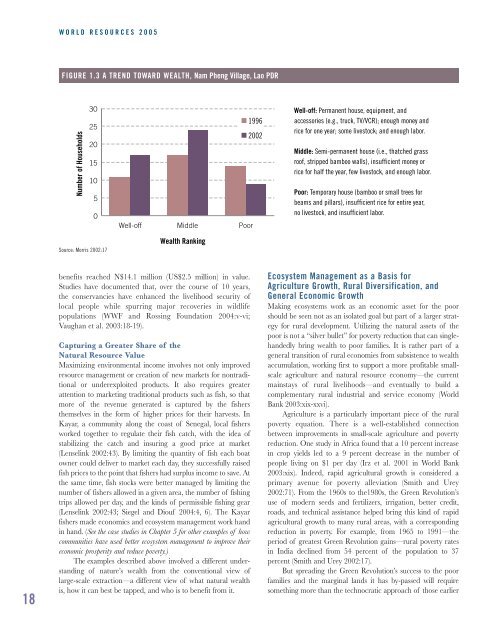jp8589 WRI.qxd - World Resources Institute
jp8589 WRI.qxd - World Resources Institute
jp8589 WRI.qxd - World Resources Institute
You also want an ePaper? Increase the reach of your titles
YUMPU automatically turns print PDFs into web optimized ePapers that Google loves.
WORLD RESOURCES 2005<br />
FIGURE 1.3 A TREND TOWARD WEALTH, Nam Pheng Village, Lao PDR<br />
Number of Households<br />
30<br />
25<br />
20<br />
15<br />
10<br />
5<br />
0<br />
Well-off Middle Poor<br />
1996<br />
2002<br />
Well-off: Permanent house, equipment, and<br />
accessories (e.g., truck, TV/VCR); enough money and<br />
rice for one year; some livestock; and enough labor.<br />
Middle: Semi-permanent house (i.e., thatched grass<br />
roof, stripped bamboo walls), insufficient money or<br />
rice for half the year, few livestock, and enough labor.<br />
Poor: Temporary house (bamboo or small trees for<br />
beams and pillars), insufficient rice for entire year,<br />
no livestock, and insufficient labor.<br />
Source: Morris 2002:17<br />
Wealth Ranking<br />
18<br />
benefits reached N$14.1 million (US$2.5 million) in value.<br />
Studies have documented that, over the course of 10 years,<br />
the conservancies have enhanced the livelihood security of<br />
local people while spurring major recoveries in wildlife<br />
populations (WWF and Rossing Foundation 2004:v-vi;<br />
Vaughan et al. 2003:18-19).<br />
Capturing a Greater Share of the<br />
Natural Resource Value<br />
Maximizing environmental income involves not only improved<br />
resource management or creation of new markets for nontraditional<br />
or underexploited products. It also requires greater<br />
attention to marketing traditional products such as fish, so that<br />
more of the revenue generated is captured by the fishers<br />
themselves in the form of higher prices for their harvests. In<br />
Kayar, a community along the coast of Senegal, local fishers<br />
worked together to regulate their fish catch, with the idea of<br />
stabilizing the catch and insuring a good price at market<br />
(Lenselink 2002:43). By limiting the quantity of fish each boat<br />
owner could deliver to market each day, they successfully raised<br />
fish prices to the point that fishers had surplus income to save. At<br />
the same time, fish stocks were better managed by limiting the<br />
number of fishers allowed in a given area, the number of fishing<br />
trips allowed per day, and the kinds of permissible fishing gear<br />
(Lenselink 2002:43; Siegel and Diouf 2004:4, 6). The Kayar<br />
fishers made economics and ecosystem management work hand<br />
in hand. (See the case studies in Chapter 5 for other examples of how<br />
communities have used better ecosystem management to improve their<br />
economic prosperity and reduce poverty.)<br />
The examples described above involved a different understanding<br />
of nature’s wealth from the conventional view of<br />
large-scale extraction—a different view of what natural wealth<br />
is, how it can best be tapped, and who is to benefit from it.<br />
Ecosystem Management as a Basis for<br />
Agriculture Growth, Rural Diversification, and<br />
General Economic Growth<br />
Making ecosystems work as an economic asset for the poor<br />
should be seen not as an isolated goal but part of a larger strategy<br />
for rural development. Utilizing the natural assets of the<br />
poor is not a “silver bullet” for poverty reduction that can singlehandedly<br />
bring wealth to poor families. It is rather part of a<br />
general transition of rural economies from subsistence to wealth<br />
accumulation, working first to support a more profitable smallscale<br />
agriculture and natural resource economy—the current<br />
mainstays of rural livelihoods—and eventually to build a<br />
complementary rural industrial and service economy (<strong>World</strong><br />
Bank 2003:xix-xxvi).<br />
Agriculture is a particularly important piece of the rural<br />
poverty equation. There is a well-established connection<br />
between improvements in small-scale agriculture and poverty<br />
reduction. One study in Africa found that a 10 percent increase<br />
in crop yields led to a 9 percent decrease in the number of<br />
people living on $1 per day (Irz et al. 2001 in <strong>World</strong> Bank<br />
2003:xix). Indeed, rapid agricultural growth is considered a<br />
primary avenue for poverty alleviation (Smith and Urey<br />
2002:71). From the 1960s to the1980s, the Green Revolution’s<br />
use of modern seeds and fertilizers, irrigation, better credit,<br />
roads, and technical assistance helped bring this kind of rapid<br />
agricultural growth to many rural areas, with a corresponding<br />
reduction in poverty. For example, from 1965 to 1991—the<br />
period of greatest Green Revolution gains—rural poverty rates<br />
in India declined from 54 percent of the population to 37<br />
percent (Smith and Urey 2002:17).<br />
But spreading the Green Revolution’s success to the poor<br />
families and the marginal lands it has by-passed will require<br />
something more than the technocratic approach of those earlier

















